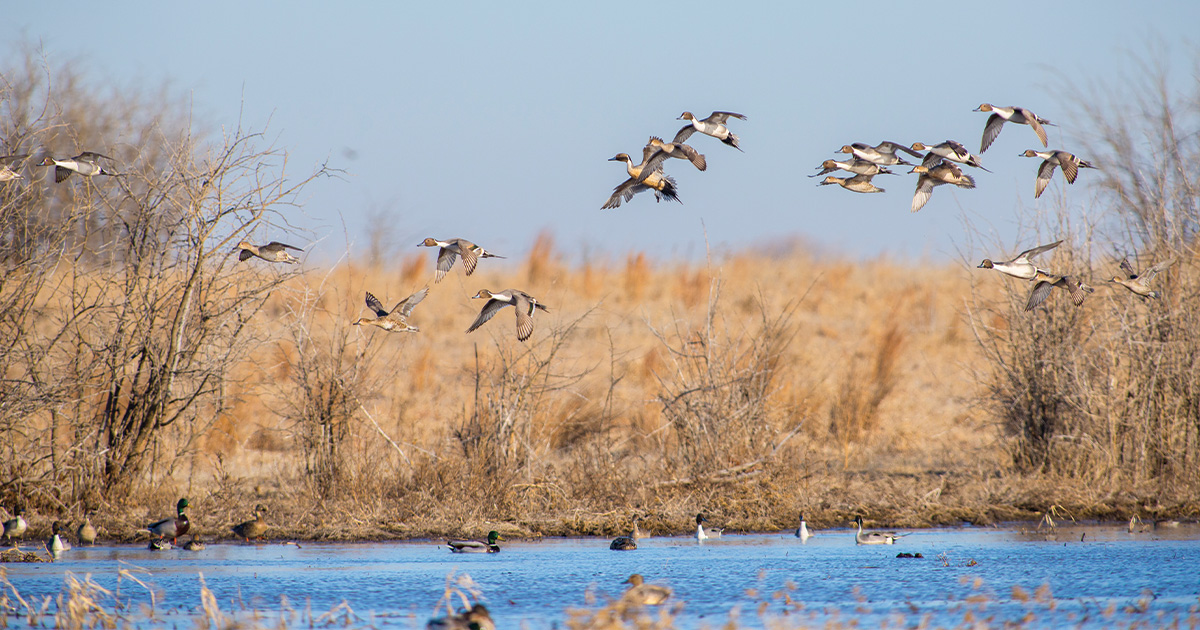Migration Alert: North Dakota Hunters Wait on Weather and Migration
Oct. 17, 2025 – Central Flyway – North Dakota
Oct. 17, 2025 – Central Flyway – North Dakota

A strong start to the waterfowl hunting season in North Dakota is beginning to wane, as locally produced ducks and geese adjust their daily routines in response to hunting pressure and relatively mild weather. Read on for a deeper look at what hunters are seeing on the ground in North Dakota, and why some are expecting more migrating birds in the weeks ahead.
The opening weeks of the waterfowl season in North Dakota have provided hunters with decent opportunities for both ducks and geese, reports Dane Buysse, a biologist for Ducks Unlimited in Bismarck. Wetlands are in good shape in those areas that received summer precipitation, and with some scouting, hunters have found pockets of locally produced ducks, including mallards, pintails, and gadwalls.
“What we’ve noticed in just the past week is that these local birds are becoming more difficult to find,” Buysse says. Some birds may have shifted to areas with lower hunting pressure, he notes, while others may have simply moved out of the state.
“In terms of a migration of birds into the state, we just haven’t seen much for ducks, so there haven’t been new birds to replace those that have moved on,” Buysse says. “We’re kind of in that in-between stage of the season when we’re waiting on some weather and the migration.”
Hunters had their eyes to the sky earlier this week when a storm dropped the first snow of the season in parts of Saskatchewan, but the general consensus is that this initial taste of winter did little to push waterfowl out of Canada.
“I think the cooler temps and big full moon last week probably had more of an impact on a migration of birds into the state,” says John Palarski, migratory game bird management supervisor with the North Dakota Game and Fish Department. “We picked up some more specks and sandhill cranes for sure, but in terms of a massive migration event, we are still waiting.”
A brief cold snap last week delivered some of the first frosty mornings of fall, but the temperatures have moderated in the days since. The short-term forecast calls for a bit of a shift early next week for the northern reaches of the Central Flyway, with another drop in temperatures accompanied by gusty northwest winds, but by the weekend, daytime highs return to the 60s.
The danger, Palarski says, is that the further into October hunters wait for a significant change in the weather, the better the chances are that the state will see a sudden, dramatic shift in conditions.
“We’ve seen it in years past when the curtain just kind of drops on the season. We finally get that weather that we’ve been waiting for, but things here lock up and the birds fly over,” Palarski says. “Hopefully that’s not the case, but the conditions are lining up a little that way.”
In the meantime, Palarski says that hunters will need to scout to find those birds that remain in the state. “There are vast areas where you’ll find good wetland conditions right now because of the precipitation that we’ve received. Conventional wisdom tells you that the birds will be spread out in small groups all across the landscape, but oddly enough we’re seeing ducks congregated in bigger numbers in select places,” he says. “You’ll drive past miles and miles of some really good-looking wetlands and not see a single duck, and then, bam, you find a pretty good bunch of birds.”
Stay up to date with the latest migration information.
Ducks Unlimited uses cookies to enhance your browsing experience, optimize site functionality, analyze traffic, and deliver personalized advertising through third parties. By continuing to use this site, you agree to our use of cookies. View Privacy Policy